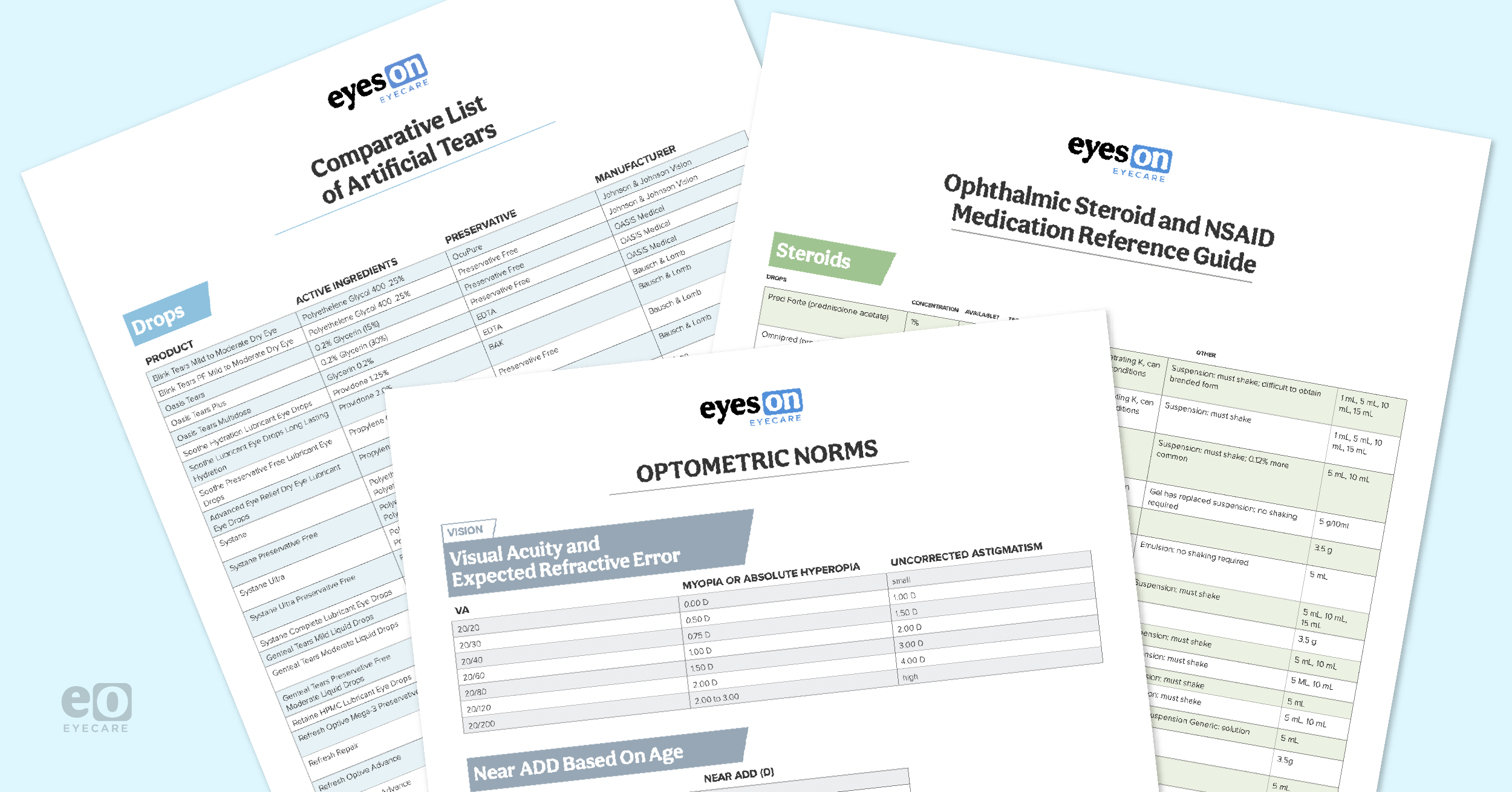Throughout your optometric journey, you will undoubtedly learn more information than you can possibly remember.
From general science to microbiology, pharmacology, ocular disease, anatomy, and physiology, there is just so much important clinical knowledge you need to cement in your mind at certain points throughout not only your academic career but your professional career as well.
We’ve created a series of Optometry Clinical Cheat Sheets for our readers to help make things a bit easier.
These Optometry Clinical Cheat Sheets are perfect for:
- Studying for class
- Studying for the NBEO Boards
- Studying for clinic
- A reference guide for when you graduate
- Something to keep in your exam room well into your career
In these Optometry Clinical Cheat Sheets, you will find:
- Comparative list of artificial tears
- Glaucoma medication reference guide
- Ophthalmic topical allergy medication reference guide
- Ophthalmic topical steroid and NSAID reference guide
- Ophthalmic topical antibiotic and antiviral drug guide
- Optometric norms for binocularity
- Optometric norms for pediatrics
- Optometric conversion tables
- Normative findings for EOMs and constrictions
- Ocular disease normative values
- Optics equations and normative values
- Vision Therapy normative values
- Properties of ophthalmic lenses
- Much more!
Medication Reference Guides
Comparative list of artificial tears
This reference guide will break down most of the major artificial tear options (roughly 60 products) by active ingredient, preservative, manufacturer, and formulation.
Glaucoma medication reference guide
This reference guide breaks down glaucoma medications by class, concentration, dosage, mechanism of action, contraindications, bottle sizes, and much more.
Ophthalmic topical allergy medication reference guide
This reference guide breaks down topical allergy medications by class, concentration, dosage, mechanism of action, contraindications, bottle sizes, and much more.
Ophthalmic topical steroid and NSAID reference guide
This reference guide breaks down these medications by concentration, bottle sizes, treatment tips and more.
Ophthalmic topical antibiotic and antiviral drug guide
This reference guide breaks down antibiotic medications by class, concentration, dosage, mechanism of action, contraindications, bottle sizes, and much more.
Optometric Norms
Optometric norms for binocularity
Included are normative values for accommodative amplitude, Worth 4 Dot, stereopsis, pursuits, and saccades.
Optometric norms for pediatrics
Some of the normative values included consist of amblyogenic refractive error and grades of retinopathy of prematurity.
Optometric norms for EOMs and constriction
This guide contains A/V patterns and EOM etiology, as well as EOM constriction manifestations and a guide to the Parks 3-Step Method.
Ocular disease normative values
All of the major ocular disease normative values are included such as cataract grading, ARMD scales, CSME criteria, expected C:D ratio based on disc diameter, Von Herick angle estimation, Becker-Shaffer angle grading, SUN Working Group of cells and flare, pachymetry, hyphema grading, cycloplegic drop information, and tear film evaluation, exophthalmometry norms, and much more!
Optics equations and normative values
Critical optics equations are included along with a table of ophthalmic lens properties.
Vision Therapy normative values
When it comes to vision therapy, there are a lot of tests and norms to know. The following is a guide highlighting some of the most critical normative values to help you along your way! You’ll find the tables broken down into:
- Morgan’s Norms for a basic vision therapy skills work up
- Findings for common binocular and accommodative disorders
- Table detailing strabismus
Conversion tables
Visual acuity and expected refractive error, a complete dioptric conversion table and keratometry conversion table, and contact lens vertexing tables are included.
How should you use the Optometry Clinical Cheat Sheets?
Load them up on an iPad or your desktop, print them out on cardstock and store them in your desk, place printed sheets in a 3-ring binder—whatever way you want to keep them on hand, because these cheat sheets are perfect for quick reference!
We hope these cheat sheets help you throughout your optometric journey, whether you are a student studying for boards, a new grad preparing for your first job, or a seasoned veteran who just needs a quick refresher every once in a while!
Download the Optometry Clinical Cheat Sheets
Get 20 pages of charts, tables, reference guides, and more.
While we make every effort to provide accurate information that is helpful to your optometry practice, this information may contain errors and is not to be used in place of your professional medical judgment. Under no circumstances shall EyesOnEyecare be responsible for damages arising from the use of this information.


